Distribution Pattern and Controlling Factors of Reef–Shoal Reservoirs on Both Sides of the Intra-Platform Depression in the Changxing Formation, Wolonghe-Yangduxi Area, Sichuan Basin
Abstract
1. Introduction
2. Regional Geological Setting
3. Materials and Methods
4. Results
4.1. Stratigraphic Divisions and Comparisons
4.2. Sedimentary Facies Types and Signs
- (1)
- Platform
- (2)
- Intra-platform Depression
- (3)
- Platform Margin Depression
- (4)
- Slope-Basin
4.3. Log Facies Characteristics
4.4. Comparison of the Development and Distribution Patterns of the Intra-Platform Shoal
4.4.1. Vertical Distribution Pattern
4.4.2. Horizontal Distribution Pattern
South Side of the Intra-Platform Depression
North Side of the Intra-Platform Depression
4.4.3. Plane Distribution Pattern of Reef Shoals in the Changxing Formation
4.4.4. Differential Sedimentary Facies Patterns on Both Sides of the Depression
4.5. Reservoir Characteristics and Distribution Pattern
4.5.1. Reservoir Diagenesis
- (1)
- Syndepositional Stage—Submarine Diagenetic Environment
- (2)
- Early Diagenetic Stage—Shallow to Intermediate Burial Environment
- (3)
- Middle Diagenetic Stage—Intermediate to Deep Burial Environment
- (4)
- Late Diagenetic Stage—Deep Burial Environment
4.5.2. Reservoir Lithology Characterization
4.5.3. Reservoir Space Types and Characteristics
4.5.4. Reservoir Petrophysical Characteristics
5. Discussion
Main Controlling Factors of Reservoir Formation
- (1)
- Sea-Level Fluctuations
- (2)
- Moderate Dolomitization
- (3)
- Dissolution-alteration
6. Conclusions
Author Contributions
Funding
Institutional Review Board Statement
Informed Consent Statement
Data Availability Statement
Acknowledgments
Conflicts of Interest
References
- Fan, J. Characteristics of carbonate reservoirs for oil and gas fields in the world and essential controlling factors for their formation. Earth Sci. Front. 2005, 12, 23–30. [Google Scholar]
- Shen, A.J.; Chen, Y.N.; Meng, S.X. The research progress of marine carbonate reservoirs in China and its significance for oil and gas exploration. Mar. Orig. Pet. Geol. 2019, 24, 1–14. [Google Scholar]
- Ma, X.H.; Yang, Y.; Wen, L.; Luo, B. Distribution and exploration direction of medium- and large-sized marine carbonate gas fields in Sichuan Basin, SW China. Pet. Explor. Dev. 2019, 46, 1–13. [Google Scholar] [CrossRef]
- Liu, S.G.; Sun, W.; Li, Z.W. Distribution characteristics of marine carbonate reservoirs and their tectonic controlling factors across the Sichuan superimposed basin. Lithol. Reserv. 2016, 28, 1–18. [Google Scholar]
- Zhang, X.H.; Tian, X.W.; Yang, D.L. Genesis and characteristics of marine carbonate reservoirs in Sichuan Basin. Nat. Gas Explor. Dev. 2021, 44, 1–10. [Google Scholar]
- Huang, S.P.; Jiang, Q.C.; Feng, Q.F. Type and distribution of Mid-Permian Maokou Formation karst reservoirs in southern Sichuan Basin, SW China. Pet. Explor. Dev. 2019, 46, 281–289. [Google Scholar] [CrossRef]
- Qin, P.; Hu, Z.G.; Wu, S.Y. Vertical heterogeneity and formation mechanism of the platform edge reef and bank reservoir in Changxing Formation of eastern Sichuan Basin. Acta Petrol. Mineral. 2018, 37, 61–74. [Google Scholar]
- Hu, Z.G.; Hu, M.Y.; Liao, J. Sedimentary facies and evolution model of reef deposition in Jiannan area of western Hubei. Nat. Gas Geosci. 2014, 25, 980–990. [Google Scholar]
- Jing, X.Y.; Zhang, X.Q.; Gao, L.; Zhang, M.D.; Li, G.R. Research on the Reservoir Characteristies and Controlling Factors of the Changxing Formation Reef in Yuanba Gas Field of Sichuan Basin, China. Northwestern Geol. 2021, 54, 188–197. [Google Scholar]
- Liu, Y.T. Reservoir characteristics of Changxing-Feixianguan Formation in northeastern Sichuan area. Lithol. Reserv. 2019, 31, 78–86. [Google Scholar]
- Zhang, S.Y. Analysis of Main Controlling Factors of Petroliferous Property and Favorable Area Prediction of Changxing Formation in the Northeastern Sichuan Basin. Master’s Thesis, China University of Petroleum, Beijing, China, 2023. [Google Scholar]
- Cheng, X.; Chen, L.; Liu, F. Development characteristics and migration law of Changxing Formation reefs in eastern Sichuan Basin. Fault-Block Oil Gas Field 2022, 29, 26–32. [Google Scholar]
- Xu, M.; Liang, H.; Wang, L.Y. Spatial distribution and migration model of the Feixianguan oolitic beach reservoir in Sichuan Basin, China. Geophys. Prospect. Pet. 2021, 60, 496–504. [Google Scholar]
- Li, H.W.; Tang, H.; Su, C.P. Characteristics of weathering crust at top of the Upper Permian Changxing Formation in Fuling area, eastern Sichuan Basin and its geological significance. J. Palaeogeogr. 2015, 17, 477–492. [Google Scholar]
- Liang, X.; Tong, M.S.; Liang, F. Characteristics of the east section of the Late Permian Yanting-Pengxi intracratonic sag and its controlling effects on the hydrocarbon accumulation of the Changxing Formation in the middle Sichuan Basin. Nat. Gas Geosci. 2019, 30, 176–189. [Google Scholar]
- Pang, Y.R.; Hu, Z.G.; Hu, M.Y. Sedimentary characteristics and favorable reservoir plays in Upper Permian Changxing Formation in Fuling area in Sichuan Basin. Pet. Geol. Oilfield Dev. Daqing 2022, 4, 20–30. [Google Scholar]
- Dong, Q.M.; Hu, Z.G.; Cai, J.L. Sequence stratigraphy and isotope geochemical response and development pattern of reef and shoal: A case study of Changxing Formation in the marginal zone of Eastern Sichuan Chengkou—Western Hubei Oceanic Trough. Pet. Geol. Exp. 2019, 41, 243–250. [Google Scholar]
- Wei, Z.B.; Chen, L.; Feng, L. Sedimentary facies and reservoir development characteristics of Changxing Formation in Fengjie area, eastern Sichuan Basin. Fault-Block Oil Gas Field 2021, 28, 816–822. [Google Scholar]
- Li, R.; Hu, Z.G. Depositional Pattern and Reservoir Distribution of Changxing Formation Intra-platform Reef and Shoal in Wolonghe-Yangduxi Zone of eastern Sichuan Basin. Acta Sedimentol. Sin. 2016, 34, 973–982. [Google Scholar]
- Hu, Z.G.; Li, R.; Hu, M.Y. Internal structure and development model of intra-platform reef and shoal of Changxing Formation in Huayingshan area, eastern Sichuan. Lithol. Reserv. 2015, 27, 67–73. [Google Scholar]
- Guo, X.S.; Huang, R.C.; Zhang, D.W.; Li, S.J.; Shen, B.J.; Liu, T.J. Hydrocarbon accumulation and orderly distribution of whole petroleum system in marine carbonate rocks of Sichuan Basin, SW China. Pet. Explor. Dev. 2024, 51, 852–869. [Google Scholar] [CrossRef]
- Wei, G.; Yang, W.; Liu, M.; Xie, W.R.; Jin, H.; Wu, S.J.; Su, N.; Shen, J.H.; Hao, C.G. Distribution rules, main controlling factors and exploration directions of giant gas fields in the Sichuan Basin. Nat. Gas Ind. B 2019, 6, 1–12. [Google Scholar] [CrossRef]
- Noyahr, C.V.; Weissenberger, J.A.W.; Harris, N.B.; Banks, J. A facies- and sequence stratigraphy-based reservoir model for a carbonate reef complex: South Swan Hills oil pool, Alberta. Mar. Pet. Geol. 2023, 152, 106226. [Google Scholar] [CrossRef]
- Ryan, J.E.; Smithers, G.S.; Lewis, E.S.; Clark, T.R.; Zhao, J.X. The influence of sea level and cyclones on Holocene reef flat development: Middle Island, central Great Barrier Reef. Coral Reefs 2016, 35, 805–818. [Google Scholar] [CrossRef]
- Violette, C.; Adjeroud, M.; Payri, C.; Sam, J.P.; Serge, A. Changes of Tiahura (Moorea Island) reef flat habitats using 67 years of remote sensing observations. Coral Reefs 2024, 43, 1775–1792. [Google Scholar] [CrossRef]
- Rebelo, T.B.; Batezelli, A.; Mattos, N.; Leite, E.P.N. Flow units in complex carbonate reservoirs: A study case of the Brazilian pre-salt. Mar. Pet. Geol. 2022, 140, 105639. [Google Scholar] [CrossRef]
- Wadas, S.H.; von Hartmann, H. Porosity estimation of a geothermal carbonate reservoir in the German Molasse Basin based on seismic amplitude inversion. Geotherm. Energy 2022, 10, 13. [Google Scholar] [CrossRef]
- Richard, J.; Sizun, J.-P. Control on carbonate reservoir properties along a shallowing-upward sequence: The middle oxfordian jura inner platform predictive model. Mar. Pet. Geol. 2023, 150, 106133. [Google Scholar] [CrossRef]
- Wen, J.; Peng, J.; Chen, Y.L. Study on sequence stratigraphy of Canglangpu Formation in the central-northern Sichuan Basin. Fault-Block Oil Gas Field 2020, 27, 424–431. [Google Scholar]
- Zhang, S.H.; Tian, J.; Ye, S.J. Dynamic accumulation process of fault-translocation natural gas accumulation model: A case study on the gas reservoir of the second Member of Upper Triassic Xujiahe Fm in the Xinchang structural zone of the Western Sichuan Depression. Nat. Gas Ind. 2019, 39, 49–56. [Google Scholar]
- Wang, D.; Liu, H.; Tang, S. Sedimentary architecture and distribution of intra-platform shoal in sequence framework of Permian Changxing Formation in central Sichuan Basin, SW China. Pet. Explor. Dev. 2023, 50, 346–359. [Google Scholar] [CrossRef]
- Wang, L.X.; Tang, M.Y.; Li, H. Precise identification of sedimentary events based on logging curve analysis. Nat. Gas Ind. 2022, 42, 50–57. [Google Scholar]
- Xiao, D. An inland facies-controlled eogenetic karst of the carbonate reservoir in the Middle Permian Maokou Formation, southern Sichuan Basin, SW China. Mar. Pet. Geol. 2016, 72, 218–233. [Google Scholar] [CrossRef]
- Li, Q.F.; Miao, S.D.; Li, Y.X. Reservoir characteristics and genesis of the Changxing Formation on the marginof Yanting-Tongnan Trough, central Sichuan Basin. Earth Sci. 2018, 43, 223–237. [Google Scholar]
- Jiang, Y.Q.; Zhou, Y.D.; Chen, Z.Y. Sedimentary pattern and exploration significance of Permian reefs and shoals in intraplatform depressions, eastern Sichuan Basin. Nat. Gas Geosci. 2019, 30, 1539–1550. [Google Scholar]
- Duan, J.B.; Tang, D.H.; Li, R.B. Comparative study ofreef in depression and shelf edge in paleo-ocean of Changxing Period Late Permian in Sichuan Basin. J. Mar. Sci. 2016, 34, 11. [Google Scholar]
- Tucker, M.E.; Wright, V.P. Carbonate Sedimentology; Blackwell Science Ltd.: Malden, MA, USA, 1990. [Google Scholar]
- Wen, L.; Zhang, Q.; Yang, Y.; Liu, H.Y.; Che, Q.; Liu, W.; Zeng, Y.X.; Wei, X.W.; Xu, L.; Liu, M.; et al. Factors controlling reef-bank reservoirs in the Changxing-Feixianguan Formations in the Sichuan Basin and their play fairways. Nat. Gas Ind. 2012, 32, 39–44. [Google Scholar]
- Yi, L.; Liu, Z.; Zou, C.N. Joint control over reservoirs by faults and uplifts: Formation of large-scale gas reservoirs in marginal reefs of carbonate tableland. China Pet. Explor. 2016, 21, 44–52. [Google Scholar]
- Zhang, Q.; Liu, L.Z.; Song, H.L.; Jin, C.S.; Qiao, N.; Qi, L. Modification of dolomitization on reservoir spaces in reef–shoal complex: A case study of Permian Changxing Formation, Sichuan Basin, SW China. Open Geosci. 2024, 16, 20220734. [Google Scholar] [CrossRef]
- Luo, W.; Shi, Z.; Tian, Y. Characteristics and Forming Processes of Reef-Shoal Reservoir in Changhsing Formation of the Eastern Sichuan Basin in Dianjiang, China. Arab. J. Sci. Eng. 2021, 47, 725–737. [Google Scholar] [CrossRef]
- Adjenovi, D.; Kilibarda, Z.; Radulovi, N. Late Triassic to Late Jurassic evolution of the Adriatic carbonate platform and Budva Basin, southern Montenegro. Sediment. Geol. 2008, 204, 1–17. [Google Scholar] [CrossRef]
- Ruppel, S.C.; Ward, W.B. Outcrop-based characterization of the Leonardian carbonate platform in West Texas: Implications forsequence-stratigraphic styles in the Lower Permian. AAPG Bull. 2013, 97, 223–250. [Google Scholar] [CrossRef]
- Yasir, B.; Muhammad, A.F.; Ajay, B.; Amir, A.B.; Syed, H.A.; Qazi, S.I. Seismic expression of miocene carbonate platform and reservoir characterization through geophysical approach: Application in central Luconia, offshore Malaysia. J. Pet. Explor. Prod. 2021, 11, 1533–1544. [Google Scholar] [CrossRef]
- Stephen, N.E.; Hyunhee, B. Deposition, diagenesis and reservoir quality of an Oligocene reefal-margin limestone succession: Asmari Formation, United Arab Emirates. Sediment. Geol. 2019, 1, 393–394. [Google Scholar] [CrossRef]
- Aghda, S.M.F.; Taslimi, M.; Fahimifar, A. Adjusting porosity and permeability estimation by nuclear magnetic resonance: A case study from a carbonate reservoir of south of Iran. J. Pet. Explor. Prod. Technol. 2018, 8, 1113–1127. [Google Scholar] [CrossRef]
- Gu, Y.F.; Jiang, Y.Q.; Lei, X.H.; Chen, Z.Y.; Zhou, L.; Fu, Y.H.; Jiang, Z.Z. The Major Controlling Factors and Different Oolitic Shoal Reservoir Characteristics of the Triassic Feixianguan Formation, Eastern Longgang Area, NE Sichuan Basin, SW China. Acta Geol. Sin.-Engl. Ed. 2021, 95, 895–908. [Google Scholar] [CrossRef]
- Wang, H.; Zhou, Q.M.; Zhou, W.; Zhang, Y.D.; He, J.H. Carbonate Platform Reef-Shoal Reservoir Architecture Study and Characteristic Evaluation: A Case of S Field in Turkmenistan. Energies 2022, 15, 226. [Google Scholar] [CrossRef]
- Li, B.; Goldberg, K. Diagenesis and reservoir quality of Cambrian carbonates in the Tarim Basin, northwestern China. J. Asian Earth Sci. 2022, 223, 104972. [Google Scholar] [CrossRef]
- Zhu, Y.J.; Zheng, J.F.; Zhang, J.K.; Luo, X.S.; Yu, G.; Li, J.; Hu, F.J.; Yang, G. Facies, Depositional Environment and Reservoir Quality of an Early Cambrian Carbonate Ramp in the Tarim Basin, NW China. Minerals 2023, 13, 791. [Google Scholar] [CrossRef]
- Jiang, L.; Worden Richard, H.; Cai, C.F.; Shen, A.J.; Crowley Stephen, F. Diagenesis of an evaporite-related carbonate reservoir in deeply buried Cambrian strata, Tarim Basin, northwest China. AAPG Bull. 2018, 102, 77–102. [Google Scholar] [CrossRef]
- Zhao, R.; Wu, Y.S.; Jiang, H.X.; Liu, Q.S. Oxygen isotope clue to migration of dolomitizing fluid as exampled by the Changxing Formation dolomite at Panlongdong, northeastern Sichuan. J. Earth Sci. 2017, 28, 333–346. [Google Scholar] [CrossRef]
- Ma, Y.S.; Cai, X.Y.; Zhao, P.R. Characteristics and formation mechanism of Changxing Formation-Feixianguan Formation reef-shoal reservoirs in Yuanba Gasfield. Pet. Res. 2016, 1, 123–134. [Google Scholar] [CrossRef]
- Ning, M.; Lang, X.G.; Huang, K.J.; Li, C.; Huang, T.Z.; Yuan, H.L.; Xing, C.C.; Yang, R.Y.; Shen, B. Towards understanding the origin of massive dolostones. Earth Planet. Sci. Lett. 2020, 545, 116403. [Google Scholar] [CrossRef]
- Elliot, H.; Enrique, G.; Diego, J.M.M.; Joyce, N.; Ramon, S.; Joan, G. Depositional and structural controls on a fault-related dolostone formation (Maestrat Basin, E Spain). Basin Res. 2022, 34, 961–990. [Google Scholar] [CrossRef]
- Kelly, E.H.; Robert, G.L.; Charles, K. Stratal architecture of a halokine-tically controlled patch reef complex and implications for reservoir quality: A case study from the Aptian James Limestone in the Fairway Field, East Texas Basin. Sediment. Geol. 2019, 387, 87–103. [Google Scholar] [CrossRef]
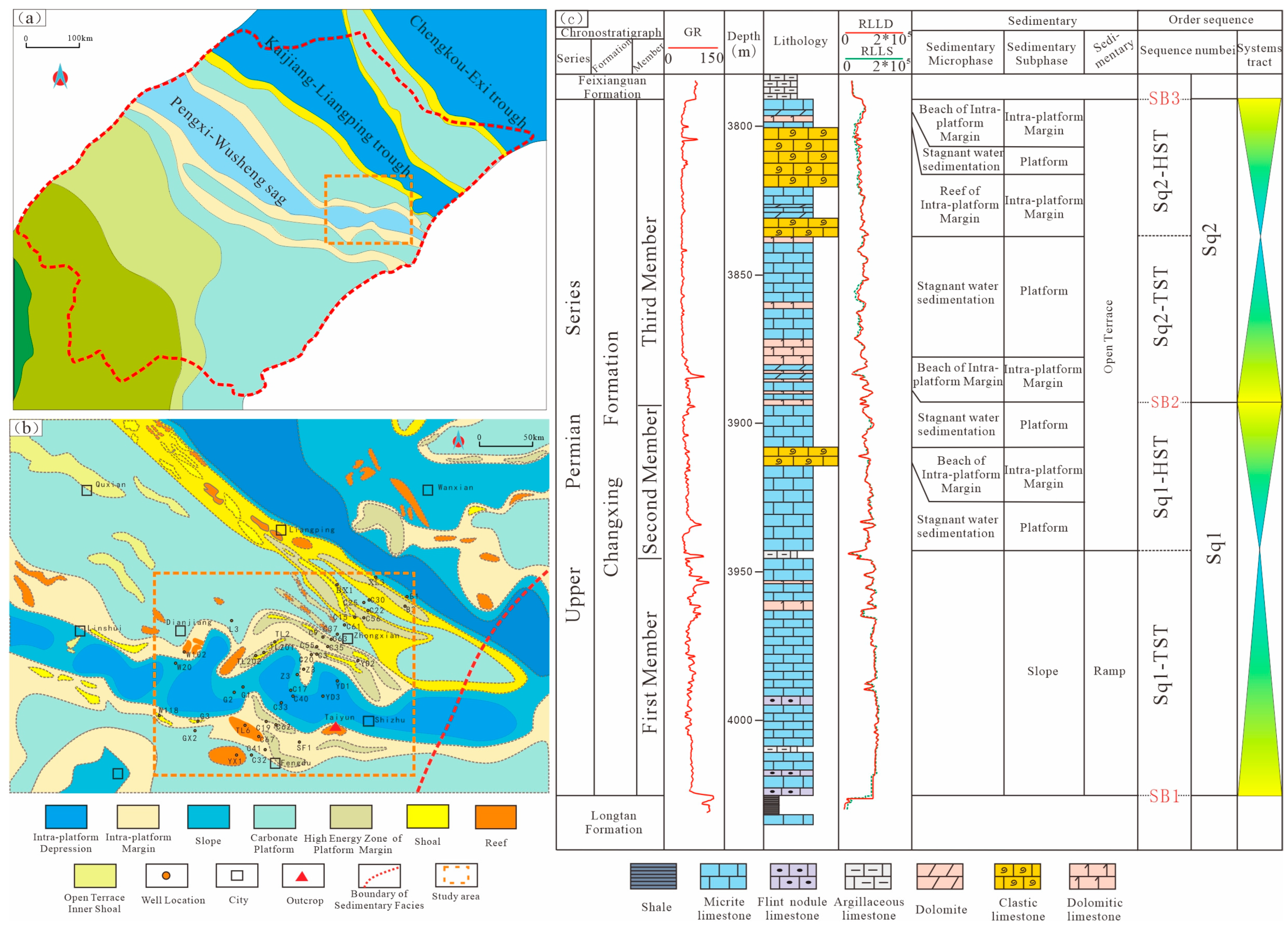
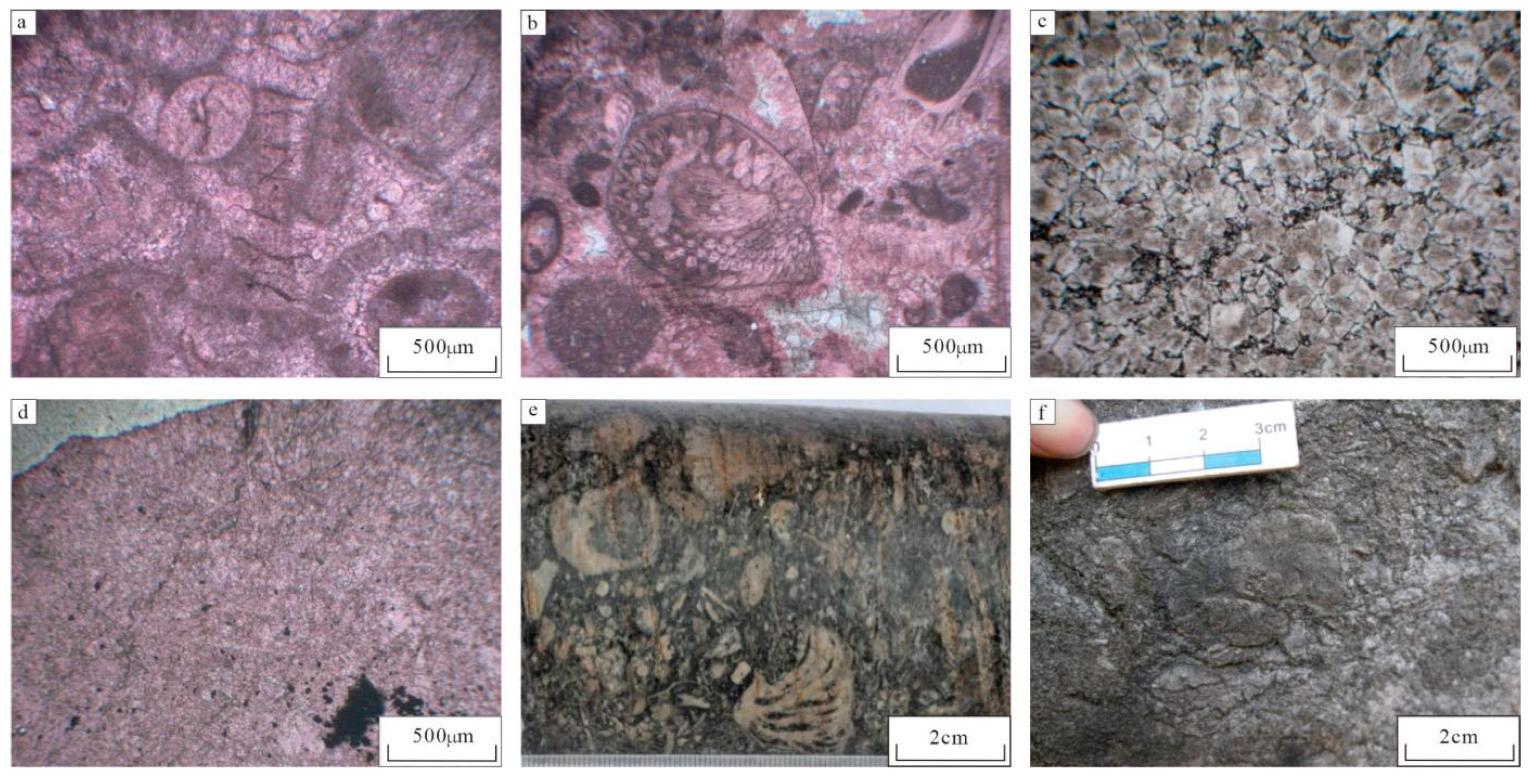

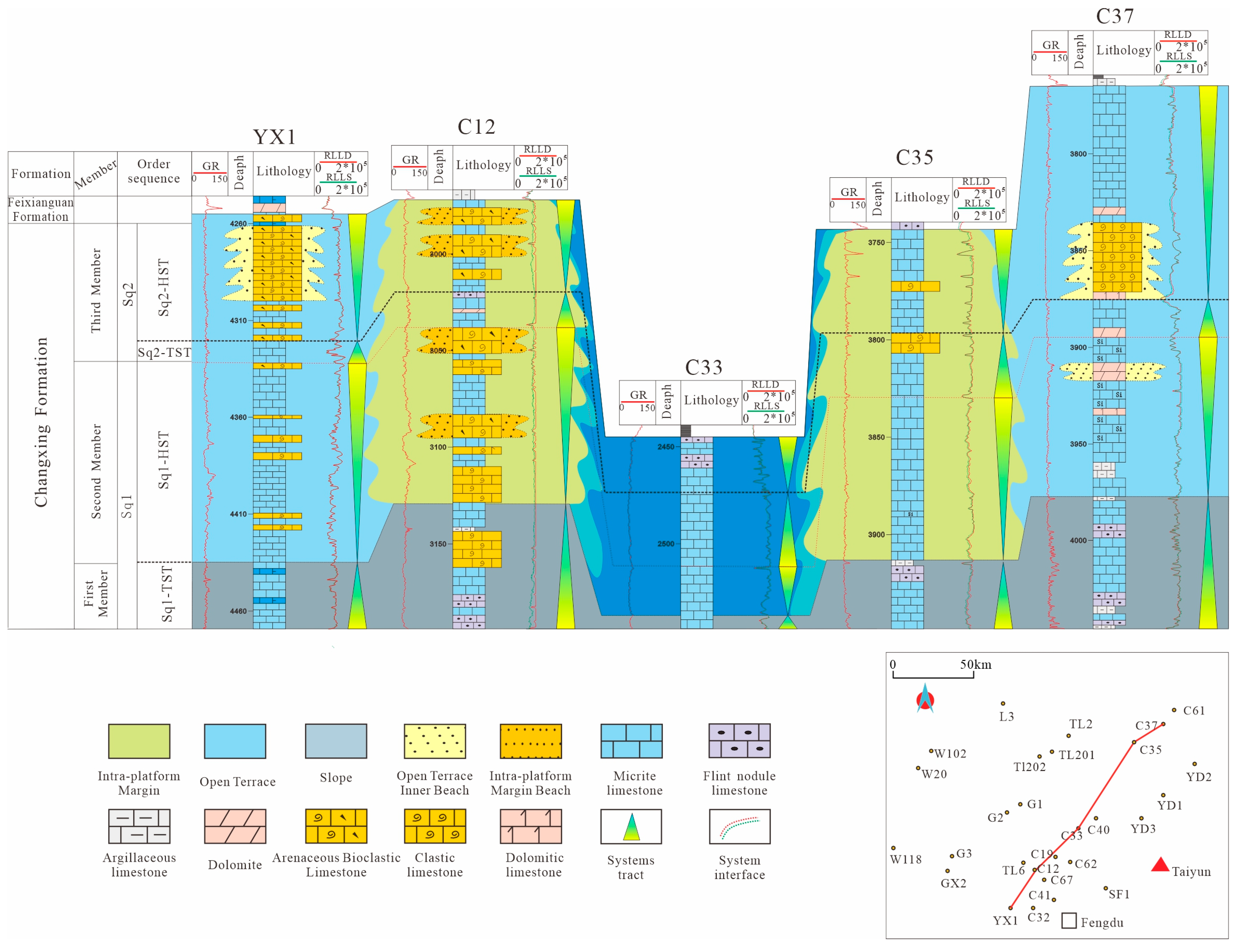
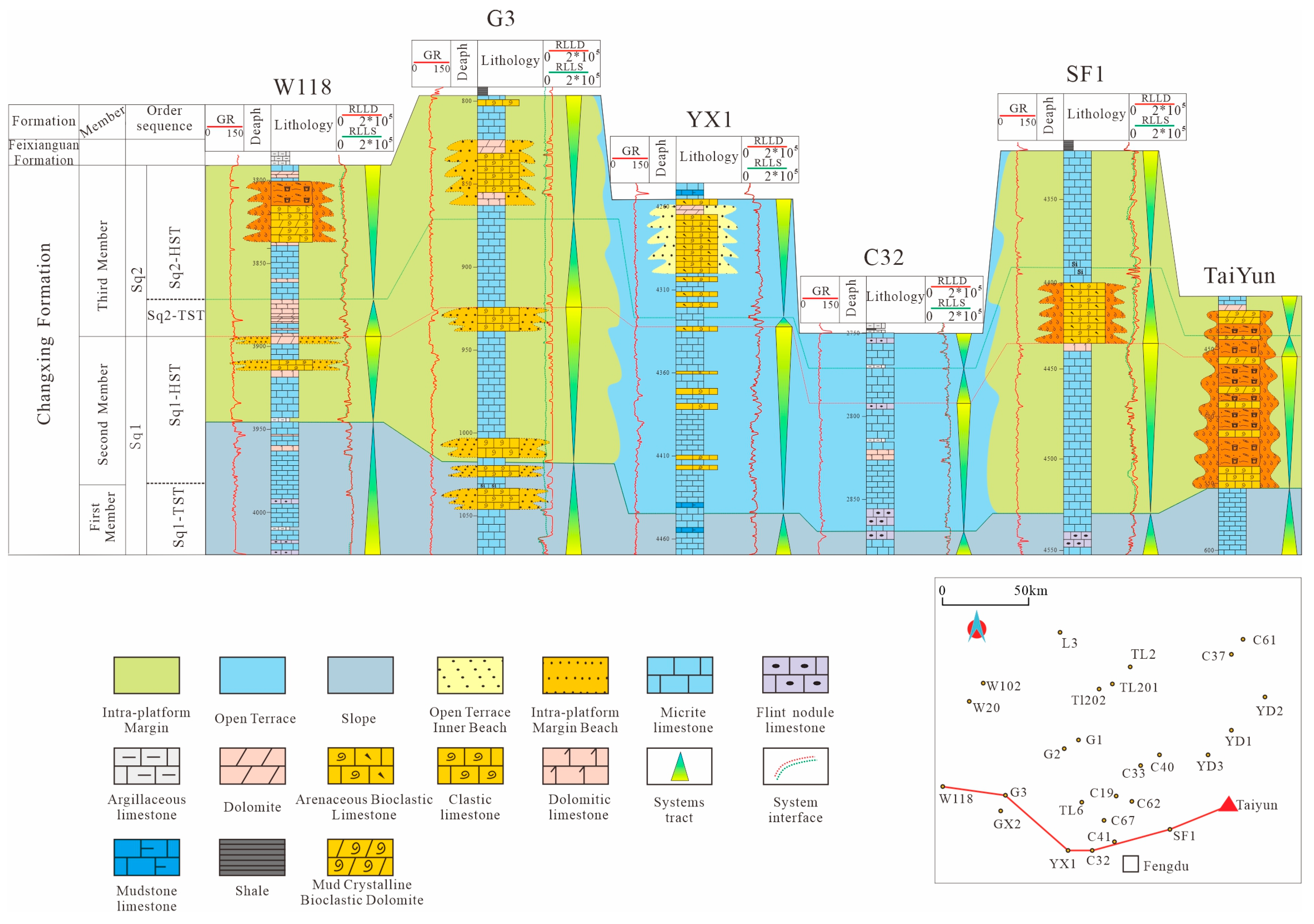
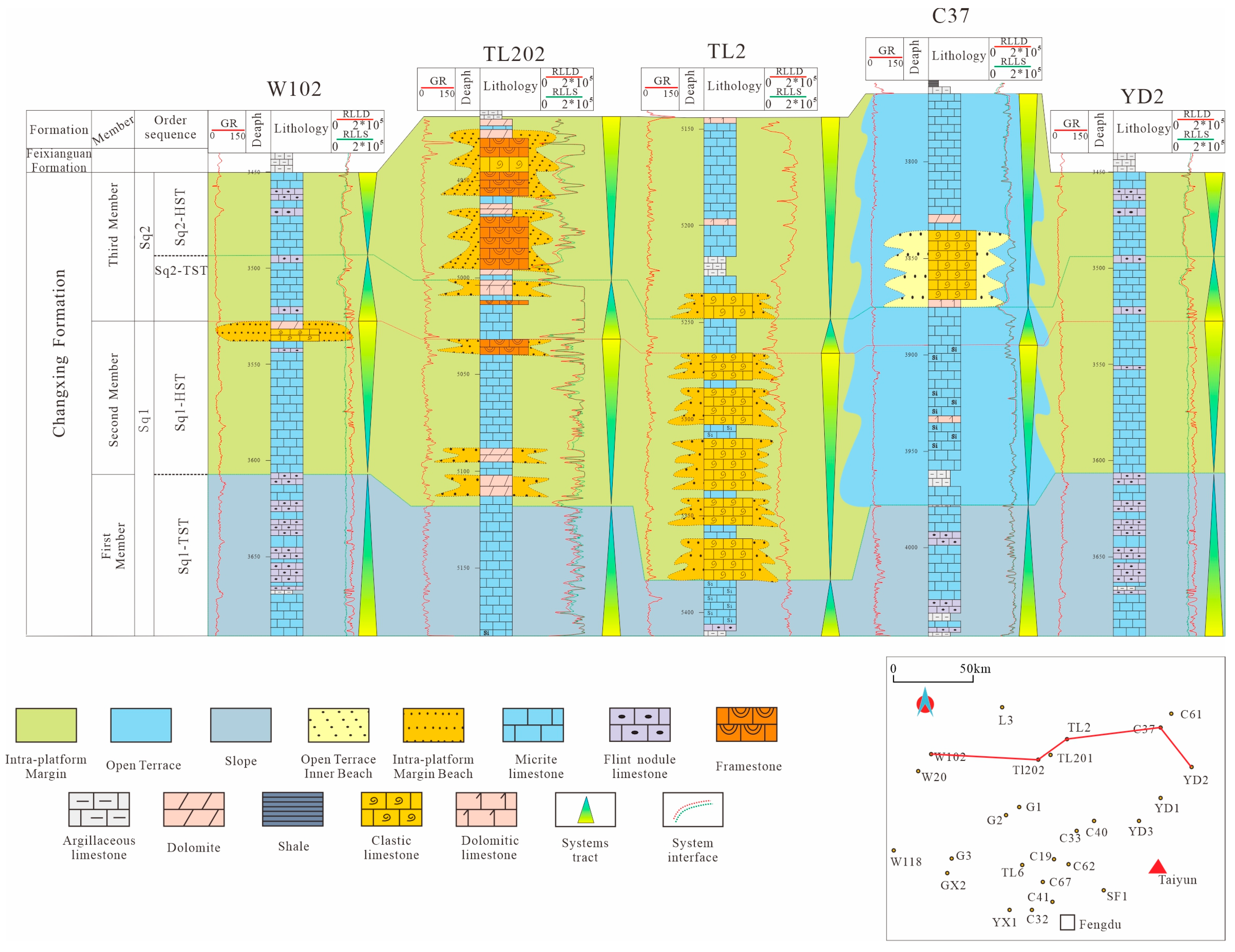
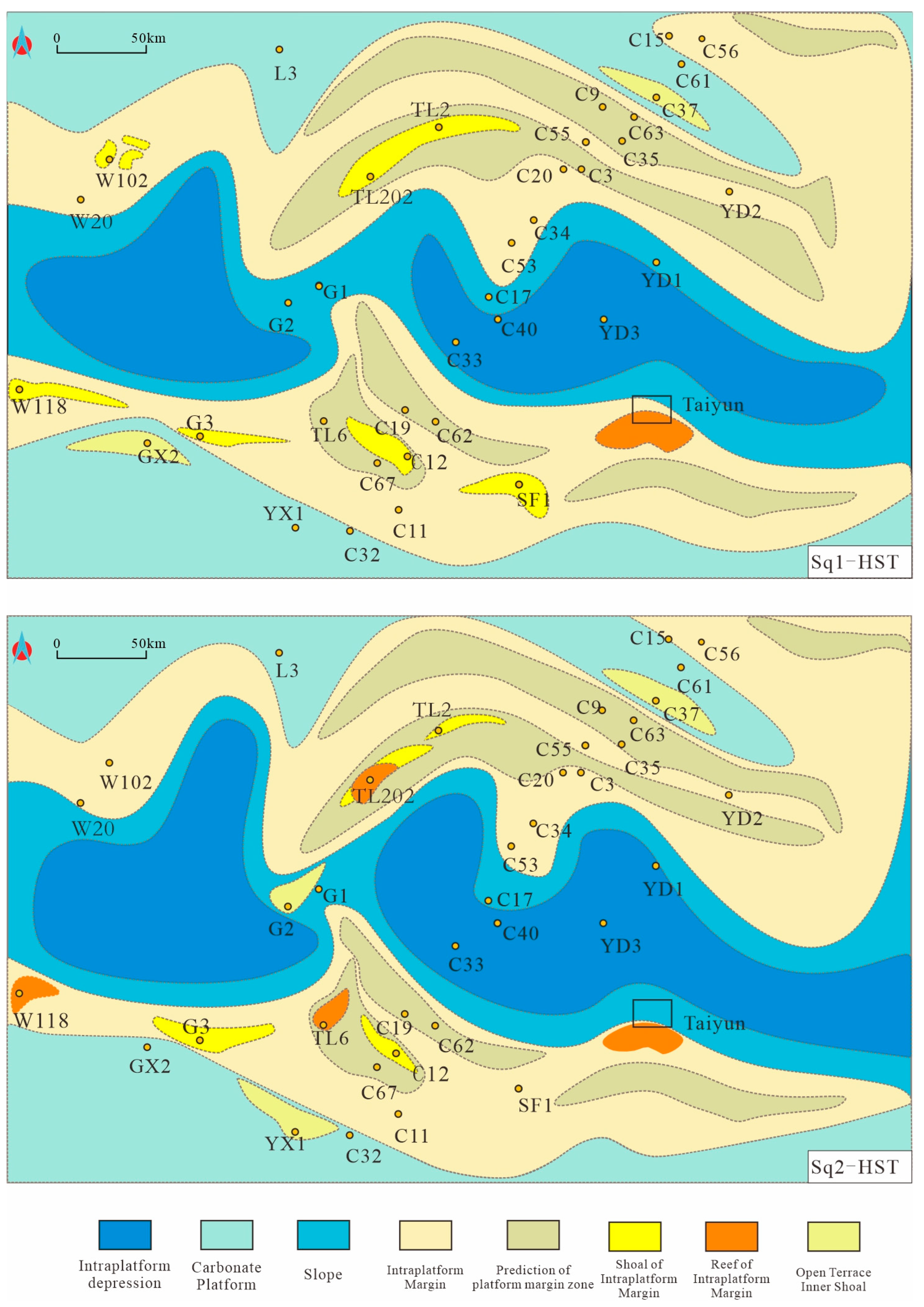
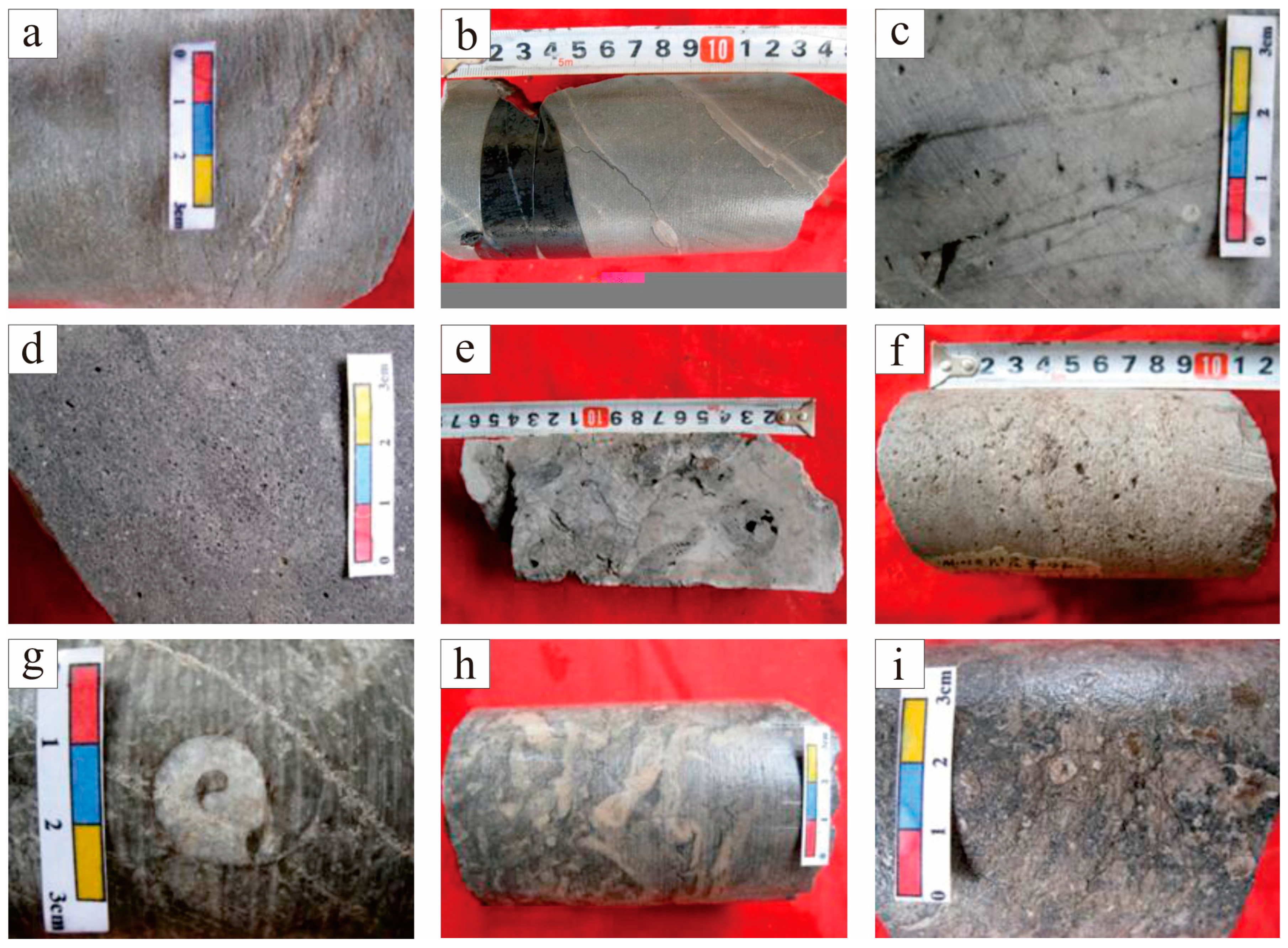
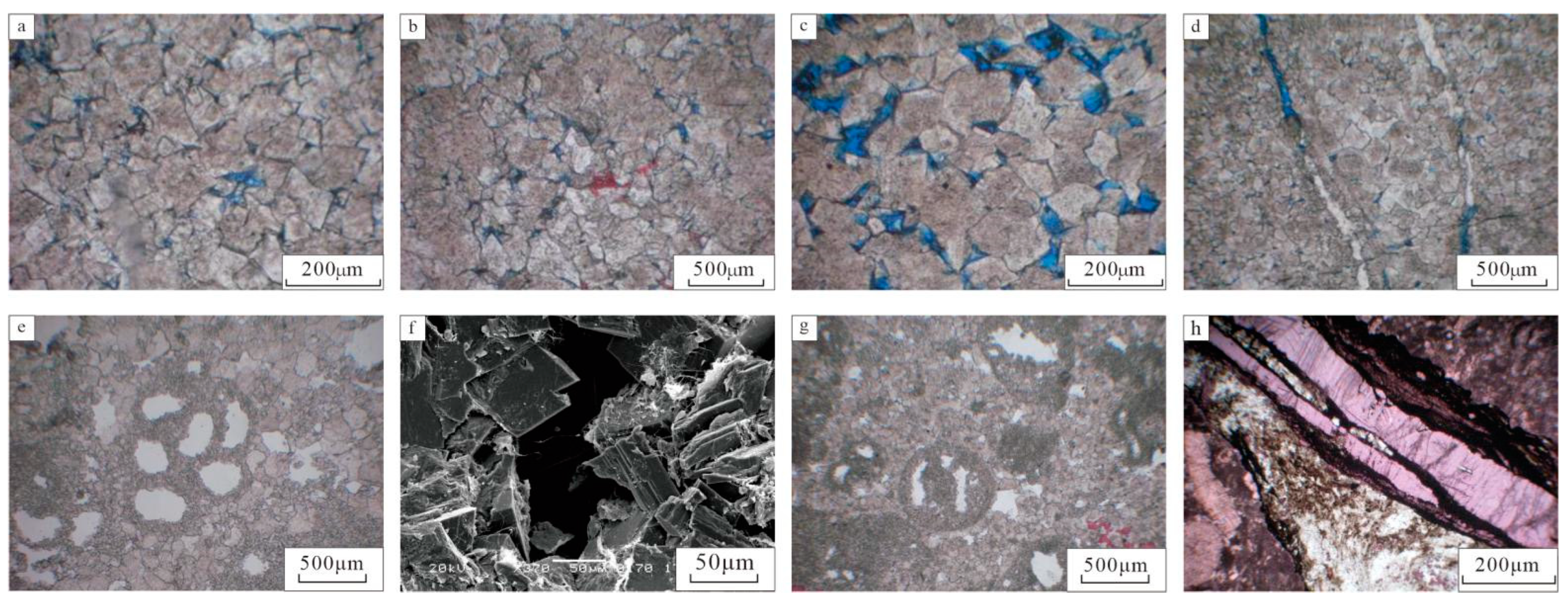
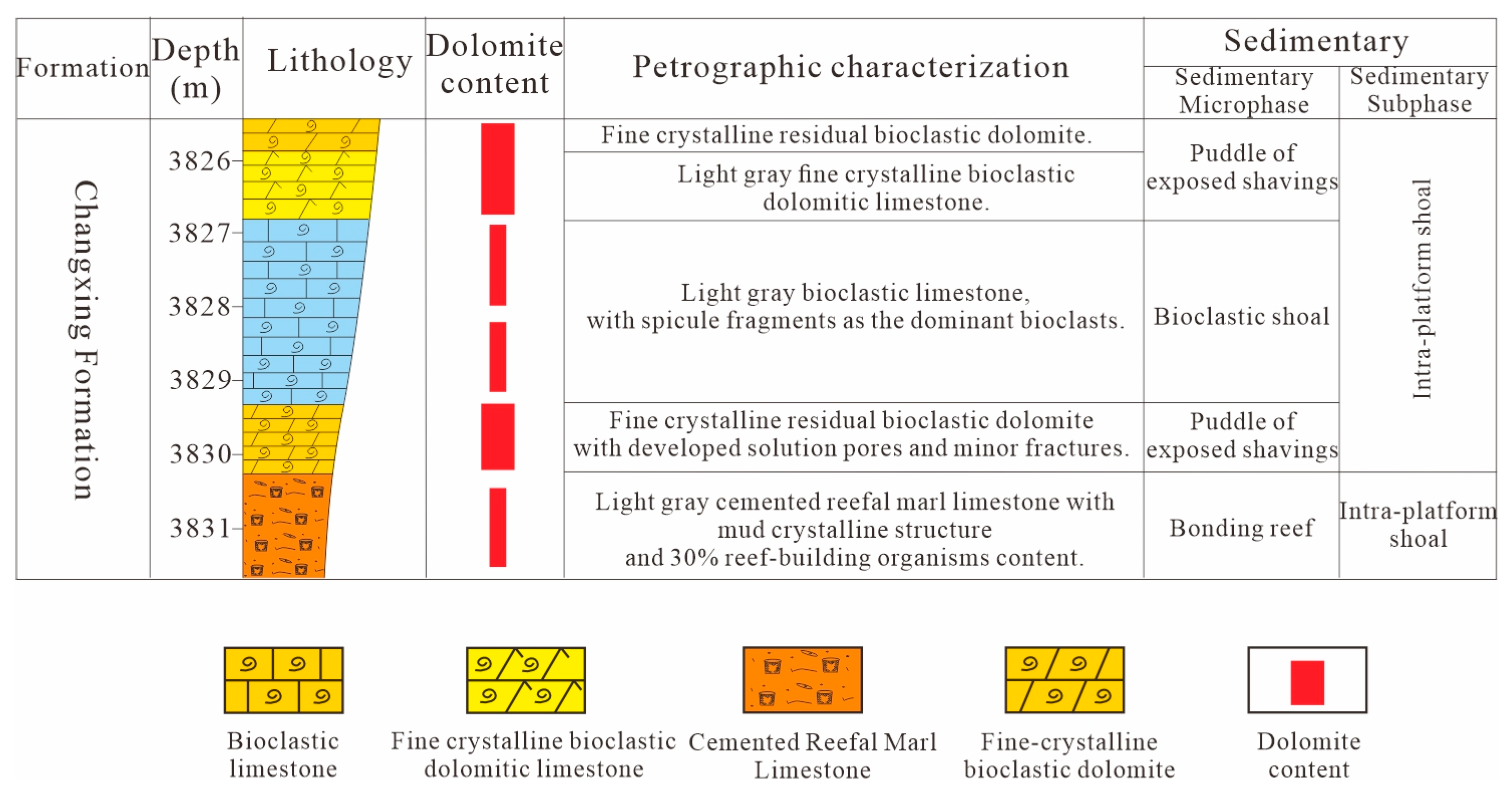
| Well | Porosity (%) | Permeability (×10−3 μm2) | ||||
|---|---|---|---|---|---|---|
| Minimum Value | Maximum Value | Average Value | Minimum Value | Maximum Value | Average Value | |
| C37 | 0.31 | 4.65 | 0.78 | 0.01 | 80.50 | 3.54 |
| GX4 | 0.82 | 0.87 | 0.84 | |||
| S15 | 0.20 | 22.05 | 4.27 | 0.01 | 746.00 | 27.27 |
| S18 | 1.19 | 21.99 | 6.74 | 0.01 | 204.00 | 14.86 |
| W102 | 0.67 | 7.40 | 2.43 | 0.01 | 4.36 | 0.23 |
| W117 | 0.31 | 14.25 | 4.60 | 0.01 | 342.00 | 3.45 |
| W118 | 0.65 | 7.92 | 1.73 | 0.01 | 6.91 | 0.21 |
| W49 | 0.23 | 2.19 | 0.88 | 0.00 | 57.90 | 1.09 |
| W75 | 0.24 | 1.60 | 0.59 | 0.00 | 4.71 | 0.10 |
| W84 | 0.16 | 4.12 | 0.54 | 0.01 | 12.85 | 0.35 |
Disclaimer/Publisher’s Note: The statements, opinions and data contained in all publications are solely those of the individual author(s) and contributor(s) and not of MDPI and/or the editor(s). MDPI and/or the editor(s) disclaim responsibility for any injury to people or property resulting from any ideas, methods, instructions or products referred to in the content. |
© 2025 by the authors. Licensee MDPI, Basel, Switzerland. This article is an open access article distributed under the terms and conditions of the Creative Commons Attribution (CC BY) license (https://creativecommons.org/licenses/by/4.0/).
Share and Cite
Bi, Y.; Hu, Z.; Wu, S.; Hu, J.; Tong, W.; Yao, M. Distribution Pattern and Controlling Factors of Reef–Shoal Reservoirs on Both Sides of the Intra-Platform Depression in the Changxing Formation, Wolonghe-Yangduxi Area, Sichuan Basin. Appl. Sci. 2025, 15, 2128. https://doi.org/10.3390/app15042128
Bi Y, Hu Z, Wu S, Hu J, Tong W, Yao M. Distribution Pattern and Controlling Factors of Reef–Shoal Reservoirs on Both Sides of the Intra-Platform Depression in the Changxing Formation, Wolonghe-Yangduxi Area, Sichuan Basin. Applied Sciences. 2025; 15(4):2128. https://doi.org/10.3390/app15042128
Chicago/Turabian StyleBi, Yuhang, Zhonggui Hu, Saijun Wu, Jiuzhen Hu, Weijie Tong, and Min Yao. 2025. "Distribution Pattern and Controlling Factors of Reef–Shoal Reservoirs on Both Sides of the Intra-Platform Depression in the Changxing Formation, Wolonghe-Yangduxi Area, Sichuan Basin" Applied Sciences 15, no. 4: 2128. https://doi.org/10.3390/app15042128
APA StyleBi, Y., Hu, Z., Wu, S., Hu, J., Tong, W., & Yao, M. (2025). Distribution Pattern and Controlling Factors of Reef–Shoal Reservoirs on Both Sides of the Intra-Platform Depression in the Changxing Formation, Wolonghe-Yangduxi Area, Sichuan Basin. Applied Sciences, 15(4), 2128. https://doi.org/10.3390/app15042128





